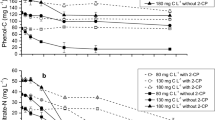Abstract
Anaerobic dehalogenation of aromatic compounds is a well-documented phenomenon. However, the effects of operating parameters such as pH have received little attention despite their potential impact on treatment processes using dehalogenating organisms. In this work the effect of pH on the dehalogenation of 2,4,6-trichlorophenol (2,4,6-TCP) was studied using defined media containing one of several non-fermentable buffering agents (MOPS, TRICINE, BICINE, CHES), and no chloride ions. The dechlorination process was followed by monitoring the disappearance of 2,4,6-TCP, as well as the appearance of its dehalogenation products, i.e., 2,4-dichlorophenol (2,4-DCP), 4-chlorophenol (4-CP), and chloride ions. The results indicate that dechlorination occurs only if the pH is within the range 8.0–8.8. The newly formed 2,4-DCP was also dehalogenated in the process. However, even within this pH range dechlorination ceased when all 2,4,6-TCP and 2,4-DCP was converted to 4-CP. Stoichiometric amounts of all dehalogenation products (including chloride) could be recovered at any stage during the process. In addition, the biomass concentration was measured. After an initial lag phase, it appeared that the rate of dechlorination per unit biomass (proportional to the Cl− concentration divided by the biomass concentration) went through a rapid increase and then remained constant throughout the process. This indicates that the dechlorinating organism(s) either make up the entire population or constitute a stable fraction of it.
Similar content being viewed by others
References
Armenante PM, Kafkewitz D, Lewandowski G, Kung CM (1992) Integrated anaerobic-aerobic process for the biodegradation of chlorinated aromatic compounds. Environ Prog 11:113–122
Battersby NS, Wilson V (1989) Survey of the anaerobic biodegradation potential of organic chemicals in digesting sludge. Appl Environ Microbiol 55:433–439
Boyd SA, Sheldon DR (1984) Anaerobic biodegradation of chlorophenols in fresh and acclimated sludge. Appl Environ Microbiol 47:272–277
Boyd SA, Sheldon DR, Berry D, Tiedje JM (1983) Anaerobic biodegradation of phenolic compounds in digested sludge. Appl Environ Microbiol 46:50–54
Bryant FO, Hale DD, Rogers JE (1991) Regiospecific dechlorination of pentachlorophenol by dichlorophenol-adapted microorganisms in freshwater, anaerobic sediment slurries. Appl Environ Microbiol 57:2293–2301
Chaudry GR, Chapalamadagu S (1991) Biodegradation of halogenated organic compounds. Microb Rev 55:59–79
DeWeerd KA, Suflita JM (1990) Anaerobic aryl reductive dehalogenation of halobenzoates by cell extracts of “Desulfomonile tiedjei”. Appl Environ Microbiol 56:2999–3005
DeWeerd KA, Concannon F, Suflita JM (1991) Relationship between hydrogen consumption, dehalogenation, and the reduction of sulfur oxyanions by Desulfomonile tiedjei. Appl Environ Microbiol 57:1929–1934
Dietrich G, Winter J (1990) Anaerobic degradation of chlorophenols by an enrichment culture. Appl Microbiol Biotechnol 34:253–258
Fathepure BZ, Vogel TM (1991) Complete degradation of polychlorinated hydrocarbons by a two-stage biofilm reactor. Appl Environ Microbiol 57:3418–3422
Good NE, Izawa S (1972) Hydrogen ion buffers. Methods Enzymol 24:53–68
Häggblom MM, Young LY (1990) Chlorophenol degradation coupled to sulfate reduction. Appl Environ Microbiol 56:3255–3260
Hendriksen HV, Larsen S, Ahring BK (1992) Influence of a supplemental carbon source on anaerobic dechlorination of pentachlorophenol in granular sludge. Appl Environ Microbiol 58:365–370
Holliger C, Shraa G, Stams AJM, Zehnder AJB (1992) Enrichment and properties of an anaerobic mixed culture reductively dechlorinating 1,2,3-trichlorobenzene to 1,3-dichlorobenzene. Appl Environ Microbiol 58:1636–1644
Hrudey SE, Knettig E, Daignault SA, Fedorak FM (1987) Anaerobic biodegradation of monochlorophenols. Environ Technol Lett 8:65–76
Kafkewitz D, Armenante PM, Lewandowski G, Kung CM (1992) Dehalogenation and mineralization of 2,4,6-trichlorophenol by the sequential activity of anaerobic and aerobic microbial populations. Biotechnol Lett 14:143–148
Kiyohara H, Hatta T, Ogawa Y, Kakuda T, Yokohama H, Takizawa N (1992) Isolation of Pseudomonas pickettii strains that degrade 2,4,6-trichlorophenol and their dechlorination of chlorophenols. Appl Environ Microbiol 58:1276–1283
Knackmuss HJ (1982) Xenobiotic degradation in industrial sewage: haloaromatics as target substrates. Biochem Soc Symp 48:173–190
Knackmuss HJ, Hellwig M (1978) Utilization and cooxidation of chlorinated phenols by Pseudomonas sp. B13. Arch Microbiol 117:1–7
Kohring G-W, Rogers JE, Wiegel J (1989) Anaerobic biodegradation of 2,4-dichlorophenol in freshwater lake sediments at different temperatures. Appl Environ Microbiol 55:348–353
Lowry OH, Rosebrough NH, Farr AL, Randall RJ (1951) Protein measurement with the Folin phenol reagent. J Biol Chem 193:265–275
Madsen T, Aamand J (1991) Anaerobic transformation and toxixity in a stable enrichment culture. Appl Environ Microbiol 58:557–561
Madsen T, Licht D (1992) Isolation and characterization of an anaerobic chlorophenol-transforming bacterium. Appl Environ Microbiol 58:2874–2878
Mikesell MD, Boyd SA (1986) Complete reductive dechlorination and mineralization of pentachlorophenol by anaerobic microorganisms. Appl Environ Microbiol 52:861–865
Mohn WW, Kennedy KJ (1992a) Reductive dehalogenation of chlorophenols by Desulfomonile tiedjei DCB-1. Appl Environ Microbiol 58:1367–1370
Mohn WW, Kennedy KJ (1992b) Limited degradation of chlorophenols by anaerobic sludge granules. Appl Environ Microbiol 58:2131–2136
Mohn WW, Tiedje JM (1990) Strain DCB-1 conserves energy for growth from reductive dechlorination coupled to formate oxidation. Arch Microbiol 153:267–271
Mohn WW, Tiedje JM (1992) Microbial reductive dehalogenation. Microbiol Rev 56:482–507
Nicholson DK, Woods SL, Istok JD, Peek DC (1992) Reductive dechlorination of chlorophenols by a pentachlrophenol-acclimated methanogenic consortium. Appl Environ Microbiol 58:2280–2286
Suflita JM, Miller GD (1985) Microbial metabolism of chlorophenolic compounds in ground water aquifers. Environ Toxicol Chem 4:751–848
Woods SL, Ferguson JF, Benjamin FF (1989) Characterization of chlorophenol and chloromethoxibenzene biodegradation during anaerobic treatment. Environ Sci Technol 23:62–68
Zhang X, Wiegel J (1990) Sequential anaerobic degradation of 2,4-dichlorophenol in freshwater sediments. Appl Environ Microbiol 56:1119–1127
Author information
Authors and Affiliations
Additional information
Correspondence to: P. M. Armenante
Rights and permissions
About this article
Cite this article
Armenante, P.M., Kafkewitz, D., Jou, CJ. et al. Effect of pH on the anaerobic dechlorination of chlorophenols in a defined medium. Appl Microbiol Biotechnol 39, 772–777 (1993). https://doi.org/10.1007/BF00164465
Received:
Accepted:
Issue Date:
DOI: https://doi.org/10.1007/BF00164465




